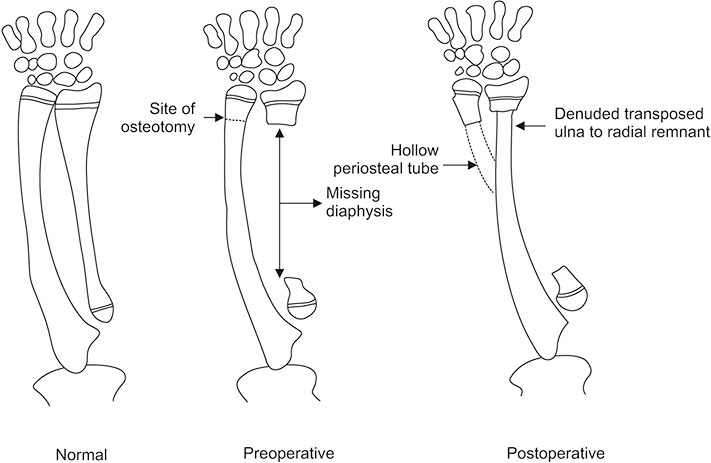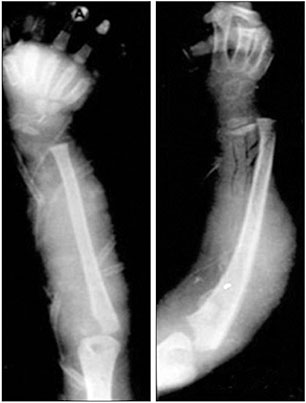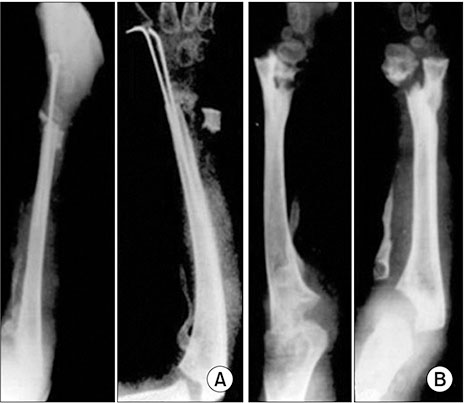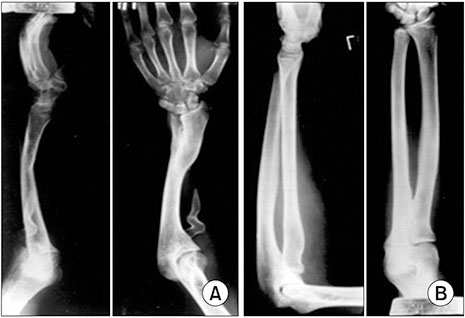Clin Orthop Surg.
2018 Jun;10(2):265-268. 10.4055/cios.2018.10.2.265.
Traumatic Absence of the Shaft of the Radius in a Child: A 15-Year Follow-up after Reconstruction by a Modified Define's One Bone Forearm Procedure
- Affiliations
-
- 1Department of Orthopaedic Surgery, Cheju Halla General Hospital, Jeju, Korea. msmoonos@hotmail.com
- 2Department of Orthopaedic Surgery, Samsung Medical Center, Sungkyunkwan University School of Medicine, Seoul, Korea.
- 3CurenCare Research, Seoul, Korea.
- KMID: 2411755
- DOI: http://doi.org/10.4055/cios.2018.10.2.265
Abstract
- Traumatic absence of the entire radial shaft in children has not been reported though there are a few reports of adult cases. We report a 5-year-old boy with traumatic absence of the entire right radial shaft. The Define's reconstruction procedure was chosen to localize the surgery only to the distal forearm and avoid further additional damage to the forearm muscles. The child's forearm was successfully reconstructed by the authors' modified Define's procedure, which was followed until his maturity. Hand function was well maintained.
Keyword
Figure
Reference
-
1. Kato K. Congenital absence of the radius: with review of literature and report of three cases. J Bone Joint Surg. 1924; 6(3):589–626.2. Starr DE. Congenital absence of the radius: a method of surgical correction. J Bone Joint Surg. 1945; 27(4):572–577.3. Lamb DW. The treatment of radial club hand: absent radius, aplasia of the radius, hypoplasia of the radius, radial paraxial hemimelia. Hand. 1972; 4(1):22–30.4. Pulvertaft RG. Twenty-five years of hand surgery: personal reflections. J Bone Joint Surg Br. 1973; 55(1):32–55.5. Lamb DW. Radial club hand: a continuing study of sixty-eight patients with one hundred and seventeen club hands. J Bone Joint Surg Am. 1977; 59(1):1–13.
Article6. Dreyfuss U. Acquired club hand: a case report. Hand. 1977; 9(3):268–271.7. Bosworth DM, Liebler WA, Nastasi AA, Hamada K. Resection of the tibial shaft for osteomyelitis in children: a thirty-two-year follow-up study. J Bone Joint Surg Am. 1966; 48(7):1328–1339.8. Moon MS, Kim CH. Healing of the bony gap with periosteal osteogenesis after tibial diaphysectomy in adult. J Korean Orthop Assoc. 1971; 6(1):75–78.
Article
- Full Text Links
- Actions
-
Cited
- CITED
-
- Close
- Share
- Similar articles
-
- Reconstruction of traumatic deficiency of forearm bone: report of Two Cases
- Treatment of Forearm Shaft Fracture with Modified Interlocking Intramedullary Nail
- Acquired club hand: Report of two cases treated with a modified Define's procedure
- Congenital Absence of the Radius: 2 cases report
- Acute Osteomyelitis in the Shaft of the Radius after Contusion of the Forearm: A Case Report






